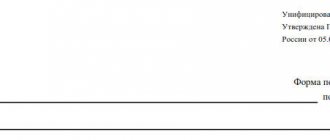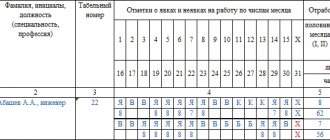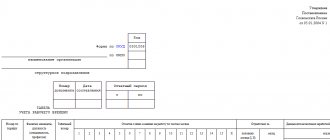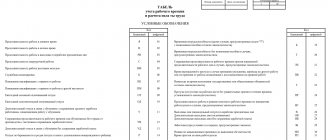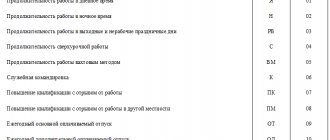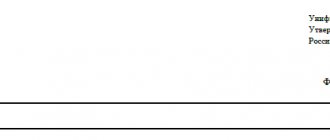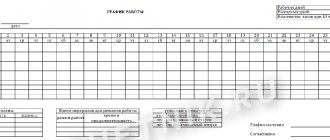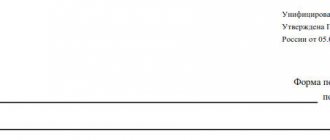Unified forms
Article 91 of the Labor Code of the Russian Federation reflects the responsibilities imposed on the head of an institution to organize control of the daily routine at the company he manages.
For this purpose, by decision of the State Statistics Committee No. 1 of 01/05/2004, unified forms (T-12 and T-13) were adopted, on which hours worked by the company’s personnel are recorded. However, the use of these templates is not necessary. The head of the enterprise has the right to adopt his own template for recording compliance with the daily routine.
Forms T-12 and T-13 differ in how they are filled out. Thus, the T-12 form is filled out when monitoring the daily routine manually, and the T-13 form is filled out when automatically recording employee attendance at work.
( Video : “Timesheet - Elena Ponomareva”)
Modern business managers prefer to work with the T-13 form, since it is easier to design.
Below is a more detailed examination of these unified forms.
Description of the document
The Labor Code of the Russian Federation, in particular Article 91, obliges employers to keep records of the time worked of each employee. The data is entered into the primary documentation form with the name list of the enterprise’s employees. Notes are also entered there on the actual use of working time by them in a given period of time. This document is called a time sheet. After the end of the billing period, the document is signed by the responsible persons and submitted to the accounting department for payroll calculation. On its basis, settlement and payment or payslips are created.
Time tracking
The timesheet can be kept in paper form, you can enter data into it on a computer, and you can also keep it online. But in this case, you will still have to print it out so that all responsible employees can sign it. Information is entered into it daily. Data must be transferred to the accounting department no later than the 12th of the current month for the first half and no later than the 25th for the entire month worked.
For your information! A blank report card can be found and downloaded for free from the Internet.
Report card
Form T-12
Form 12-F was adopted for use by Rosstat Order No. 247 dated July 13, 2010. The form records data on compliance with the daily routine in the company.
If there are separate divisions in the company structure that work with an independent balance sheet, and also record receipts of funds from the sale of products, work performed, services provided and expenses for the production activities of the department, recording of arrivals to work is carried out for each independent division.
The completed timesheets are sent by the company to the territorial structures of Rosstat at the place of registration of the enterprise or the corresponding structural department of the company.
The head of the institution, by order, appoints a person responsible for monitoring compliance with the daily routine, with the submission of a statistical report to government agencies.
Instructions for filling out a working time sheet in form T-12
When recording the arrival of personnel to work, coded symbols are entered into the timesheet, recording only those personnel who are officially employed, including internally.
Labor activity for the following composition is not taken into account:
- Working unofficially.
- Arranged on an external part-time basis.
- Executed under a civil agreement.
Maintaining the timesheet is entrusted to either the personnel officer, the head of the department, or another person appointed by order of the employer. Based on the codes recorded in the time sheet, the company’s personnel are paid salaries and other payments.
Depending on the company’s method of monitoring the daily routine, the time sheet can be drawn up either in one general form (for the entire enterprise) or in a separate form for each department.
The report card refers to a regular form submitted monthly on the date set by the company. The rules for formatting the form require correct completion of the title page and tabular section of the form.
Title page
This section of the form displays the following data:
- Company name.
- Codes OKPO and OKUD.
- The form number, which is assigned by the company independently.
- Reporting period – i.e. month during which the data is recorded.
- The date the form was compiled, which is usually the end date of the reporting month.
The address section of the form displays the full name of the institution, and subsequently, in brackets, its short name.
The “Postal Address” line displays the name of the subject of the Russian Federation, legal and actual address, with a display of the postal code.
The company code (OKPO) is displayed based on the All-Russian Classifier registered in the structures of Rosstat.
The company identification number is displayed in the same way.
Tabular part
In this section you need to fill in all the fields:
- The first column assigns a number to each employee.
- The second and third columns display personal information about the employee (full name, vacancy and personnel number).
- In the columns of the 4th and 6th columns containing the dates of the month, symbols are recorded indicating the arrival/absence of personnel at work, in which the code is written in the numerator, and the number of working hours in the denominator.
- In the 5th and 7th columns, the totals are entered, displaying the number of shifts and hours worked for the corresponding part of the month.
- From the 8th to the 13th column, the final indicators of labor activity for the month are filled in, displaying the shifts worked and hours at the company.
- The 14th column records missed shifts, with the reasons for absences displayed in the 15th and 16th columns.
- And finally, the 17th column indicates the number of weekends and holidays.
At this point, work with the report card is completed, and the responsible employee must sign the completed form, filling in the date and signature.
Sample of filling out form No. T-12
Form T-13
As has already been written in the previous sections, the T-13 form is used in those companies where automatic recording of compliance with the daily routine has been established by installing turnstiles at the entrance.
Form T-13 is regulated by the decision adopted by the State Statistics Committee No. 1 of 01/05/2004. For accounting, the proposed form is the basis for all charges. Thanks to this method of accounting, personnel officers are able to track the attendance of personnel at their workplaces according to the established schedule. Such a form can also become the basis for imposing penalties on a person who violates the work schedule.
When filling out this form, code symbols are also used to record the work activity of the working person.
Note. Form T-13 is not mandatory. The head of the company has the right to approve his own template.
Title page
1. This page is filled with:
- The name of the company, the structural department that records compliance with the daily routine.
- Form number.
- Date of its signing.
- Fixation period.
- OKUD and OKPO codes.
Tabular part
2. In this section, fill in the following information:
- The first column displays the serial number of the working person.
- In the 2nd and 3rd columns, as in the T-12 form, the full name is written. employee, vacancy and personnel number.
- Column 4 records visits to work by the employed person.
- In the 5th and 6th columns, the results of the worked period are filled in, respectively - for the first half of the month and for the entire month.
- On the next page of the form, in columns from 7 to 13, the final data for salary calculation, the number of absences and reasons are filled in, indicating the record data with code values.
- Finally, the completed T-13 form is signed by the responsible employee, the head of the department, or the personnel officer, and the date of the completed form is recorded.
Instructions for filling
The head of the company is responsible for the established daily routine. Therefore, it is within his authority to develop instructions for maintaining primary records. One of the forms of primary control is the T-13 template or another approved template at the company for monitoring the work activities of the company’s personnel.
When developing instructions for completing the T-13 form, you need to pay attention to the following points:
- If the company is large, you need to organize recording of compliance with the daily routine by structural departments. That is, each department maintains its own control.
- To do this, each branch assigns a person responsible for this area of work.
- Responsible persons are required to study the meaning of the codes used when recording data.
- The responsible person is obliged to study the procedure for entering data into the registration form in order to correctly mark arrival/miss, lateness, reasons for violations, etc.
- Enter entries into the timesheet daily.
How to properly arrange maternity leave in 2021
The term “maternity leave”, which does not exist in official legislation, usually refers to the period of absence from work associated with motherhood.
Before and after the birth of offspring, a woman receives from the state the opportunity to temporarily not fulfill her professional duties, but to devote herself to her family, without losing either her work experience or losing financial assistance.
It is useful for all working representatives of the fair sex to know how this type of leave is arranged, which most women have to encounter at least once in their lives, and often more than once. The nuances of such frequently arranged “rest” are also important for personnel service employees.
Maternity leave - comprehensive leave
The persistent jargon of “maternity leave” actually hides 2 different vacations, the only common feature of which is their connection with the birth of a child.
- Maternity leave
- Leave related to the need to care for a child up to 1.5 or three years of age.
Components of the maternity leave:
- have different bases;
- are issued separately and each in its own way;
- of various durations;
- payment differs between the employer and the state.
Rumor has united them into a common “maternity leave”, since in practice in most cases they go one after the other and have no breaks between them.
REFERENCE! Legislatively, the right to leave related to future motherhood is regulated by Art. 255-256 of the Labor Code of the Russian Federation. Special and work experience is not interrupted by a long maternity leave.
Who is entitled to maternity leave?
The Labor Code enshrines the right of any working woman to go on maternity leave, namely:
- an employee who has signed an employment contract (work experience does not matter);
- registered with the Employment Service with the official status of unemployed;
- female students studying full-time;
- a woman in military service;
- the female part of the civilian personnel of military institutions.
NOTE! Some types of paid benefits during this leave are available to everyone, and some - only to officially employed expectant mothers.
Timing is an important issue in motherhood
When establishing the duration of maternity leave and the time of leaving for it, the legislation is guided not only by the natural rhythms of childbirth, but also by the conclusions of the doctor leading the pregnant woman, which is reflected in the relevant legal acts.
Each type of leave that constitutes maternity leave has its own specific timing.
Maternity leave (Maternity leave)
In the last months leading up to childbirth, it becomes difficult for a woman, and sometimes she cannot cope with her usual work duties, and often even the journey to her place of work. The state provides her with the opportunity to be considered temporarily disabled, that is, to issue a sick leave for the prenatal and postpartum periods. The duration of these periods varies:
- before the expected birth, a woman is allowed to rest for 70 days according to the calendar;
- after childbirth, sick leave will continue for another 70 days if the birth was normal, and for 86 days in case of complicated birth situations (in particular, a cesarean section);
- if not one baby is expected to be born, but several at once, the happy mother will be allowed to rest 2 weeks earlier - the prenatal period will be 84 days;
- the parent of twins and more children after childbirth is entitled to 110 days of paid sick leave;
- The countdown of these periods begins with the issuance of a sick leave certificate at the antenatal clinic, which occurs in a normal pregnancy at 30 weeks, and in a multiple pregnancy at 28 weeks.
ATTENTION! If unexpected inconsistencies arise in the estimated dates on which the leave is based (for example, a woman gave birth prematurely, postponed the pregnancy, or the gestational age was incorrectly calculated), the leave dates remain unchanged. To extend it, you need a new sick leave and, on its basis, additional leave.
When adopting a small child (up to 3 months), a woman is also entitled to leave similar to that provided under the BiR.
Instructions for expectant mothers: how to apply for leave under BiR
- At 30 weeks (or 28, if more than 1 baby is expected), the pregnant woman receives a certificate of incapacity for work from the antenatal clinic doctor and has it certified by her supervisor.
- A pregnant employee writes an application for maternity leave to her employer in her own hand. This document must indicate the reason for future absence from work (A&W) and the terms calculated from the sick leave. It’s worth immediately adding a clause about the request to accrue the corresponding benefits, otherwise they will have to be processed separately.
- The HR department, based on the application and sick leave, issues an order to provide this type of leave. The expectant mother is completely free from labor worries from the date specified in the order.
Additionally, you need to prepare the following documents:
- copy of ID;
- a certificate from the accounting department about income for the last 2 years;
- bank account number or plastic card (for transferring benefits);
- a certificate from the housing complex stating that the woman registered before the 12-week period (an additional payment is due for early registration).
Parental leave for up to 1.5 or 3 years
Issued after the birth of the child before the expiration of postpartum vacation days: the first vacation will smoothly transition into the second.
IMPORTANT! This type of leave, unlike the first, can be issued not only to the child’s mother, but also to any person who will care for him - father, relative, guardian, the choice is up to the child’s family: it is possible if the mother has resumed working activity after the birth of the baby.
Labor guarantees for those on this leave:
- maintaining the workplace at the “pre-maternity leave” workload;
- payment of monthly “employer” compensation;
- taking into account the first 1.5 years of child care in the pension period;
- impossibility of dismissal before going to work.
FOR YOUR INFORMATION! The difference between a 1.5-year and a 3-year vacation is only in the payment of monthly benefits from the employer and the pension period. These are not different types of leave, but one, issued once, which can be completed at any convenient time before the child turns 3 years old.
Documenting
- A mother or another officially employed loved one submits a written application to her employer (it also includes requirements for the calculation of 2 monthly payments - benefits and compensation).
- Providing a birth certificate for the baby.
- If it is not the mother who arranges the leave, a certificate is needed stating that she is not using her right to maternity leave.
- Registration of the order by the HR department (the applicant receives a copy).
IMPORTANT INFORMATION! Two maternity leaves cannot be taken out at the same time.
If before the end of the maternity leave a woman is going on a second one, then the dates in the two orders should not overlap each other. In such a situation, it is financially more profitable for a woman to apply for B&R benefits than to continue to receive compensation from the employer.
Thus, it is worth writing an application for going back to work, and then for a new leave for the second pregnancy and childbirth.
For adopted children, parental leave is issued in the same manner as for relatives.
Methods for filling out the T-13 form, basic codes for filling out the timesheet
When working with timesheets, different methods are used to control the time worked by staff.
- One way is to display staff presence at work on a daily basis.
- Another way to work with a report card is to control absences and tardiness, with a description of the reasons for such violations.
To simplify the work with the time sheet, specialized codes have been adopted, thanks to which data is entered simply and quickly. Today, the following codes are used in timekeeping:
- Arrival of personnel at work according to the established schedule is displayed with the symbol “I”, or the number “01”
- A working person's scheduled vacation is indicated by the symbols “FROM” or the number 09.
- Maternity leave is assigned the code “P”, or the number 14.
- If an employee goes on leave to support a child, the code “OZH” or the number 15 is displayed.
- Vacation at your own expense is indicated by the symbols “BEFORE” or the number – 16.
- When a person is on a business trip, the symbol “K” or the number 06 is displayed.
- If you miss work due to unknown circumstances, fill in the symbols “НН” or the number 30.
- The provision of sick leave is marked with the symbol “B” or the number -19.
All company personnel involved in monitoring the daily routine and payroll are required to study the codes. Ignorance of the designation of codes can lead to incorrect calculation of wages to an employed person or to the imposition of an unreasonable punishment.
The timesheet displays all data on the work of the company’s personnel in symbolic or numerical notation. Thus, the T-12 form contains all the conditional codes that must be used when working with the report card. This ensures that errors are avoided when working with the form, as well as when deciphering the entered information by accounting employees.
How is absence from work marked?
A specific code is also provided to indicate temporary absence from work. All data in the timesheet is indicated in letter form, which allows accounting employees to clearly determine all the nuances of wage calculation, and necessarily vacation payments and sick leave payments. If a person does not go to work, but provides information that he is sick, then temporary disability under this condition is indicated by the letter “B”. There are situations when removal from professional duties occurs. “NB” is indicated on the report card. If the enterprise does not pay wages, then the employee has the right not to attend his work, and not to fulfill the obligations established by the employment agreement, in accordance with the provisions of the law. This fact is reflected in the report card with the letters “NZ”, which actually indicates a suspension of work due to the employer’s failure to fulfill all of its obligations to pay for the work performed. If removal from professional duties is carried out with accrual of payment from the employer, then in this case the value “BUT” is indicated, which allows accountants to accrue the amount of remuneration for work activities, taking into account the fact that the employee was not present during certain working days.
Who fills out the time sheet?
The legislation does not establish who is obliged to keep time records and adherence to the daily routine by the company’s personnel. Despite this, the rules for filling it out require the following:
- The timesheet must be filled out by an authorized employee.
- When submitting the form to the accounting department, the report card must be signed by the head of the department and the personnel officer, if one is on staff.
- Based on the completed timesheet, salaries are calculated for the company's personnel.
The authorized person responsible for the time sheet is appointed by the employer by appropriate order. Maintaining the timesheet can be entrusted to a personnel employee, the head of a department, and in small enterprises - to the secretary of the institution.
